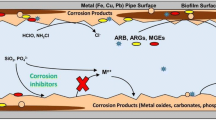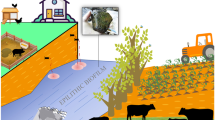Abstract
The presence of antibiotic-resistant bacteria in environmental surface waters has gained recent attention. Wastewater and drinking water distribution systems are known to disseminate antibiotic-resistant bacteria, with the biofilms that form on the inner-surfaces of the pipeline as a hot spot for proliferation and gene exchange. Pipe-based irrigation systems that utilize surface waters may contribute to the dissemination of antibiotic-resistant bacteria in a similar manner. We conducted irrigation events at a perennial stream on a weekly basis for 1 month, and the concentrations of total heterotrophic bacteria, total coliforms, and fecal coliforms, as well as the concentrations of these bacterial groups that were resistant to ampicillin and tetracycline, were monitored at the intake water. Prior to each of the latter three events, residual pipe water was sampled and 6-in. sections of pipeline (coupons) were detached from the system, and biofilm from the inner-wall was removed and analyzed for total protein content and the above bacteria. Isolates of biofilm-associated bacteria were screened for resistance to a panel of seven antibiotics, representing five antibiotic classes. All of the monitored bacteria grew substantially in the residual water between irrigation events, and the biomass of the biofilm steadily increased from week to week. The percentages of biofilm-associated isolates that were resistant to antibiotics on the panel sometimes increased between events. Multiple-drug resistance was observed for all bacterial groups, most often for fecal coliforms, and the distributions of the numbers of antibiotics that the total coliforms and fecal coliforms were resistant to were subject to change from week to week. Results from this study highlight irrigation waters as a potential source for antibiotic-resistant bacteria, which can subsequently become incorporated into and proliferate within irrigation pipe-based biofilms.





Similar content being viewed by others
References
Allen, H. K., Donato, J., Wang, H. H., Cloud-Hansen, K. A., Davies, J., & Handelsman, J. (2010). Call of the wild: antibiotic resistance genes in natural environments. Nature Reviews Microbiology, 8(4), 251–259. doi:10.1038/nrmicro2312.
Armstrong, J. L., Shigeno, D. S., Calomiris, J. J., & Seidler, R. J. (1981). Antibiotic-resistant bacteria in drinking water. Applied and Environmental Microbiology, 42(2), 277–283.
Baquero, F., Martínez, J., & Cantón, R. (2008). Antibiotics and antibiotic resistance in water environments. Current Opinion in Biotechnology, 19(3), 260–265. doi:10.1016/j.copbio.2008.05.006.
Barkay, T., Kroer, N., Rasmussen, L. D., & Sorenson, S. (1995). Conjugal gene transfer at natural population densities in a microcosmos simulating an estuarine environment. FEMS Microbiology Ecology, 16, 43–54.
Barker, J., & Brown, M. R. W. (1994). Trojan Horses of the microbial world: protozoa and the survival of bacterial pathogens in the environment. Microbiology, 140(6), 1253–1259.
Blaustein, R. A., Pachepsky, Y. A., Hill, R. L., Shelton, D. R., & Whelan, G. (2013). Escherichia coli survival in waters: temperature dependence. Water Research, 47, 569–578.
Brettar, I., & Hofle, M. G. (1992). Influence of ecosystematic factors on survival of Escherichia coli after large-scale release into lake water mesocosms. Applied and Environmental Microbiology, 58(7), 2201–2210.
Cabello, F. C. (2006). Heavy use of prophylactic antibiotics in aquaculture: a growing problem for human and animal health and for the environment. Environmental Microbiology, 8(7), 1137–1144.
Czekalski, N., Berthold, T., Caucci, S., Egli, A., & Bürgmann, H. (2012). Increased levels of multiresistant bacteria and resistance genes after wastewater treatment and their dissemination into Lake Geneva, Switzerland. Frontiers in Microbiology, 3, 106. doi:10.3389/fmicb.2012.00106.
De Lancy Pulcini, E. (2001). Bacterial biofilms: a review of current research. Néphrologie, 22(8), 439–441.
Devarajan, N., Laffite, A., Graham, N. D., Meijer, M., Prabakar, K., Mubedi, J. I., Elongo, V., Mpiana, P. T., Ibelings, B. W., Wildi, W., & Pote, J. (2015). Accumulation of clinically relevant antibiotic resistant genes, bacterial load, and metals from freshwater lake sediments in Central Europe. Environmental Science and Technology, 49, 6528–6537.
Esioubu, N., Armenta, L., & Ike, J. (2002). Antibiotic resistance in soil and water environments. International Journal of Environmental Health Research, 12, 133–144.
Flint, K. P. (1987). The long-term survival of Escherichia coli in river water. Journal of Applied Bacteriology, 63(3), 261–270.
Garcia-Armizen, T., & Servais, P. (2004). Enumeration of viable E. coli in rivers and wastewaters by fluorescent in situ hybridization. Journal of Microbiological Methods, 58, 269–279.
Gerba, C. P. (2009). The role of water and water testing in produce safety. In X. Fan, B. A. Niemira, C. J. Doona, F. E. Feeherty, & R. B. Gravani (Eds.), Microbial safety of fresh produce (pp. 129–142). New York: Wiley and Sons.
Gomez-Alvarez, V., Revetta, R. P., & Santo Domingo, J. W. (2012). Metagenome analyses of corroded concrete wastewater pipe biofilms reveal a complex microbial system. BMC Microbiology, 12(1), 122. doi:10.1186/1471-2180-12-122.
Hammer, Ø., Harper, D. A. T., & Ryan, P. D. (2001). PAST: paleontological statistics soft-ware package for education and data analysis. Palaeontologia Electronica, 4(1), 9. http://palaeo-electronica.org/20011/past/issue101.htm.
Harmel, R. D., Karthikeyan, R., Gentry, T., & Srinivasan, R. (2010). Effects of agricultural management, land use, and watershed scale on E. coli concentrations in runoff and streamflow. Transactions of the ASABE, 53(6), 1833–1841.
Hausner, M., & Wuertz, S. (1999). High rates of conjugation in bacterial biofilms as determined by quantitative in situ analysis. Applied and Environmental Microbiology, 65(8), 3710–3713.
Junco, M. T. T., Martín, M. G., Toledo, M. L. P., Gómez, P. L., & Barrasa, J. L. M. (2001). Identification and antibiotic resistance of faecal enterococci isolated from water samples. International Journal of Hygeine and Environmental Health, 203, 363–368.
Lebkowska, M. (2009). Antibiotic resistant bacteria in drinking water. Ochrona Srodowiska, 31(2), 11–15.
Li, X., Watanabe, N., Xiao, C., Harter, T., McCowan, B., Liu, Y., & Atwill, E.R. (2013). Antibiotic-resistant E. coli in surface water and groundwater in dairy operations in Northern California. Environmental Monit Assess. DOI 10.1007/s10661-013-3454-2.
Martinez, J. L. (2008). Antibiotics and antibiotic resistance genes in natural environments. Science, 321(11), 365–367.
Martinez, J. L. (2009). Environmental pollution by antibiotics and by antibiotic resistance determinants. Environmental Pollution (Barking, Essex: 1987), 157(11), 2893–902.
McCambridge, J., & McMeekin, T. A. (1980). Relative effects of bacterial and protozoan predators on survival of Escherichia coli in estuarine water samples. Applied and Environmental Microbiology, 40(5), 907–911.
Na, S. H., Miyanaga, K., Unno, H., & Tanji, Y. (2006). The survival response of Escherichia coli K12 in a natural environment. Applied Microbiology and Biotechnology, 72(2), 386–392.
Pachepsky, Y., Shelton, D. R., Mclain, J. E. T., Patel, J., & Mandrell, R. E. (2011). Irrigation waters as a source of pathogenic microorganisms in produce: a review. Advances in agronomy (1st ed., Vol. 113, pp. 73-137). Elsevier Inc. doi:10.1016/B978-0-12-386473-4.00007-5
Pachepsky, Y., Morrow, J., Guber, A., Shelton, D., Rowland, R., & Davies, G. (2012). Effect of biofilm in irrigation pipes on microbial quality of irrigation water. Letters in Applied Microbiology, 54(3), 217–224. doi:10.1111/j.1472-765X.2011.03192.x.
Pachepsky, Y. A., Blaustein, R. A., Whelan, G., & Shelton, D. R. (2014). Comparing temperature effects on Escherichia coli, Salmonella, and Enterococcus survival in surface waters. Letters in Applied Microbiology, 59, 278–283.
Pallecchi, L., Bartoloni, A., Paradisi, F., & Rossolini, G. M. (2008). Antibiotic resistance in the absence of antimicrobial use: mechanisms and implications. Expert Review of Anti-Infective Therapy, 6, 725–732.
Rice, E. W., Messer, J. W., Johnson, C. H., & Reasoner, D. J. (1995). Occurrence of high-level aminoglycoside resistance in environmental isolates of enterococci. Applied and Environmental Microbiology, 61(1), 374–376.
Sadovski, A. Y., Fattal, B., Goldberg, D., Katzenelson, E., & Shuval, H. I. (1978). High levels of microbial contamination of vegetables irrigated with wastewater by the drip method. Applied and Environmental Microbiology, 36, 824–830.
Schwartz, T., Kohnen, W., Jansen, B., & Obst, U. (2003). Detection of antibiotic-resistant bacteria and their resistance genes in wastewater, surface water, and drinking water biofilms. FEMS Microbiology Ecology, 43, 325–335.
Shelton, D. R., Kiefer, L. A., Pachepsky, Y. A., Blaustein, R. A., & Martinez, G. (2012). Coliform retention and release in biofilms formed on new and weathered irrigation pipes. Irrigation Science, 31(5), 971–981. doi:10.1007/s00271-012-0373-x.
Shelton, D. R., Kiefer, L. A., Pachepsky, Y. A., Martinez, G., McCarty, G. W., & Dao, T. H. (2013). Comparison of microbial quality of irrigation water delivered in aluminum and PVC pipes. Agricultural Water Management, 129, 145–151. doi:10.1016/j.agwat.2013.07.021.
Smith, D. L., Dushoff, J., & Morris, J. G. (2005). Agricultural antibiotics and human health. PLoS Medicine, 2(8), e232.
Stanley, N. R., & Lazazzera, B. A. (2004). Environmental signals and regulatory pathways that influence biofilm formation. Molecular Microbiology, 52(4), 917–924.
Thevenon, F., Adatte, T., Wildi, W., & Pote, J. (2012). Antibiotic resistant bacteria/genes dissemination in lacustrine sediments highly increased following cultural eutrophication of Lake Geneva (Switzerland). Chemosphere, 86(5), 468–476.
USDA-ARS. (2014). NARMS—National Antimicrobial Resistance Monitoring System Animal Isolates. <http://www.ars.usda.gov/News/docs.htm?docid=6750&page=3>.
Wellington, E. M. H., Boxall, A. B., Cross, P., Feil, E. J., Gaze, W. H., Hawkey, P. M., Johnson-Rollins, A. S., Jones, D. L., Lee, N. M., Otten, W., Thomas, C. M., & Williams, A. P. (2013). The role of the natural environment in the emergence of antibiotic resistance in gram-negative bacteria. Lancet Infectious Diseases, 13(2), 155–165. doi:10.1016/S1473-3099(12)70317-1.
Williamson, C. E., Grad, G., De Lange, H. J., Gilroy, S., & Karapelou, D. M. (2002). Temperature-dependent ultraviolet radiation responses in zooplankton: implications of climate change. Limnology and Oceanography, 47(6), 1844–1848.
Wimpenny, J. (1996). Ecological determinants of biofilm formation. Biofouling, 10, 43–63.
Yomoda, S., Okubo, T., Takahashi, A., Murakami, M., & Iyobe, S. (2003). Presence of Pseudomonas putida strains harboring plasmids bearing the Metallo-β-Lactamase gene bla IMP in a hospital in Japan. Journal of Clinical Microbiology, 41(9), 4246–4251. doi:10.1128/JCM.41.9.4246.
Author information
Authors and Affiliations
Corresponding author
Electronic supplementary material
Below is the link to the electronic supplementary material.
ESM 1
Table S-1. Probabilities that the multiple-drug resistance histograms for different bacterial groups (ref. Fig. 5) were the same on each irrigation event date. (DOCX 11 kb)
Rights and permissions
About this article
Cite this article
Blaustein, R.A., Shelton, D.R., Van Kessel, J.A.S. et al. Irrigation waters and pipe-based biofilms as sources for antibiotic-resistant bacteria. Environ Monit Assess 188, 56 (2016). https://doi.org/10.1007/s10661-015-5067-4
Received:
Accepted:
Published:
DOI: https://doi.org/10.1007/s10661-015-5067-4




